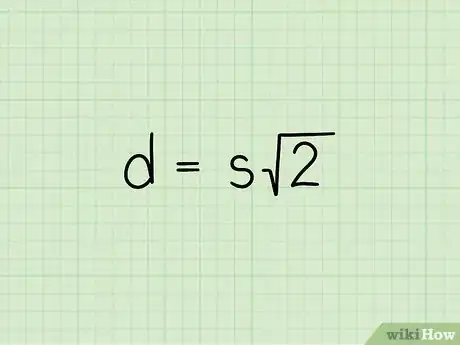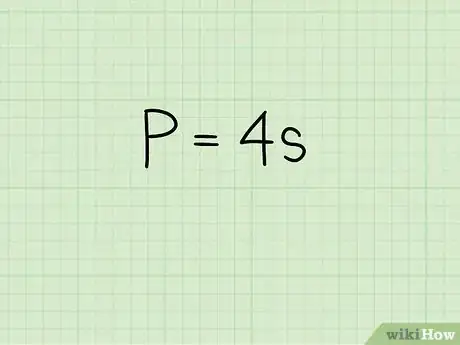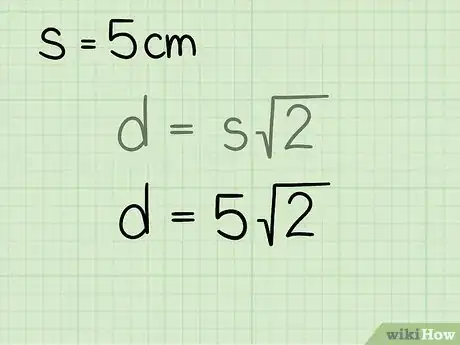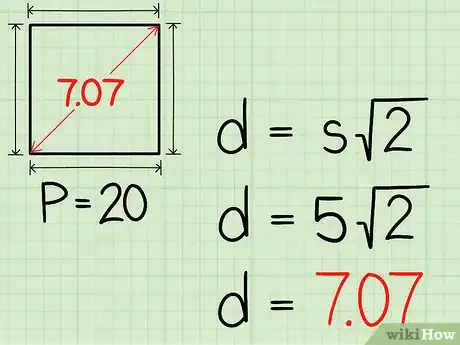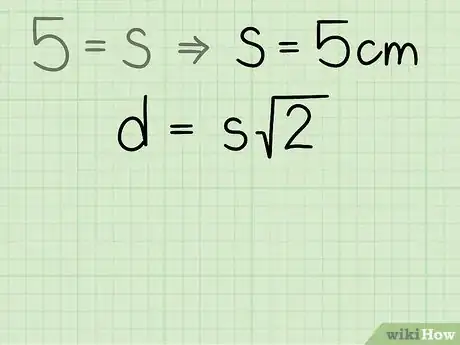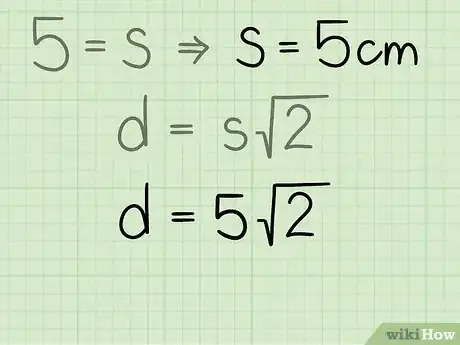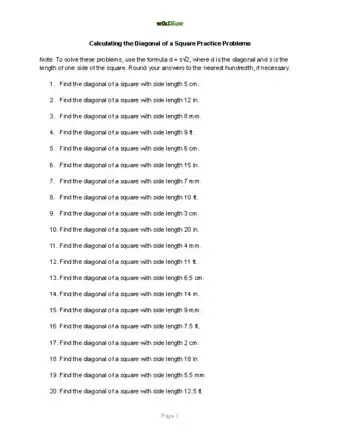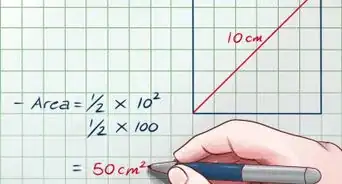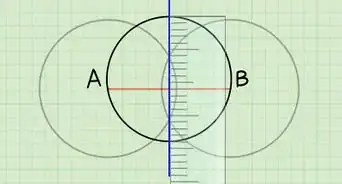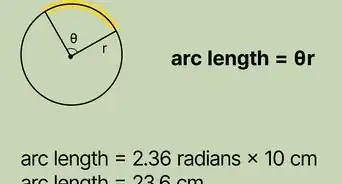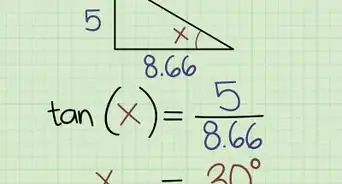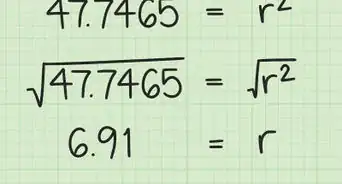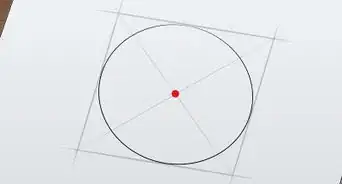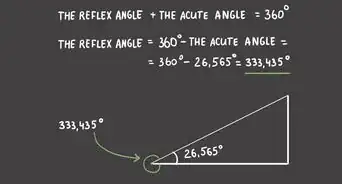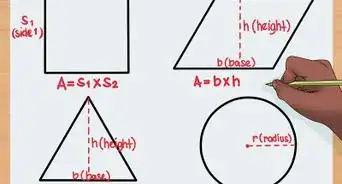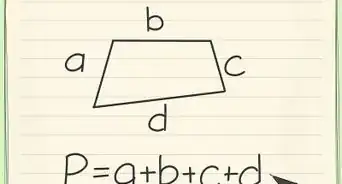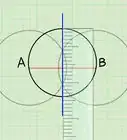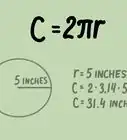This article was co-authored by David Jia. David Jia is an Academic Tutor and the Founder of LA Math Tutoring, a private tutoring company based in Los Angeles, California. With over 10 years of teaching experience, David works with students of all ages and grades in various subjects, as well as college admissions counseling and test preparation for the SAT, ACT, ISEE, and more. After attaining a perfect 800 math score and a 690 English score on the SAT, David was awarded the Dickinson Scholarship from the University of Miami, where he graduated with a Bachelor’s degree in Business Administration. Additionally, David has worked as an instructor for online videos for textbook companies such as Larson Texts, Big Ideas Learning, and Big Ideas Math.
This article has been viewed 754,104 times.
The diagonal of a square is the line stretching from one corner of the square to the opposite corner. To find the diagonal of a square, you can use the formula , where equals one side length of the square. Sometimes, however, you might be asked to find the length of the diagonal given another value, such as the perimeter or area of the square. In these instances it is necessary to use different formulas first, so that you can determine the side length before using the diagonal formula.
Steps
If You Know the Length of One Side
-
1Find the length of one side of the square. This will probably be given to you. If you are working with a square in the real world, use a ruler or piece of measuring tape to find the length. Since all four sides of the square are the same length, you can use any side of the square. If you do not know the length of one side of the square, you cannot use this method.
- For example, you might want to find the length of the diagonal of a square that has sides 5 centimeters long.
-
2Set up the formula . In the formula equals the length of the diagonal and equals one side of the square.[1]
- This formula is derived from the Pythagorean Theorem (. A diagonal divides a square into two congruent right triangles, thus, you can use the side lengths of the square to find the length of the diagonal (which would be the hypotenuse of the right triangle).[2]
Advertisement -
3Plug the side length of the square into the formula. Make sure you are substituting for the variable .
- For example, if the square has a side length of 5 centimeters, set up the formula like this:
- For example, if the square has a side length of 5 centimeters, set up the formula like this:
-
4Multiply the length of the side by . This will give you the length of the diagonal. It’s best to perform the calculation on a calculator, so that you can get a more precise result. If you don’t have a calculator, you can round to 1.414.
- For example, if you are calculating the diagonal of a 5-centimeter square, your formula will look like this:
So, the diagonal of the square is 7.07 centimeters long.
- For example, if you are calculating the diagonal of a 5-centimeter square, your formula will look like this:
If You Know the Perimeter
-
1Set up the formula for the perimeter of a square. The formula is , where equals the perimeter of the square, and equals the length of one side of the square.[3]
- This method only works if you are given the perimeter of the square.
- To find the length of the diagonal, you must first find the length of one side of the square, so you need to set up the perimeter formula and solve for .
-
2Plug the length of the perimeter into the formula. Make sure you are substituting for the variable .
- For example, if the perimeter of the square is 20 centimeters, your formula will look like this:
- For example, if the perimeter of the square is 20 centimeters, your formula will look like this:
-
3Solve for . To do this, divide each side of the equation by 4. This will give you the length of one side of the square.
- For example:
- For example:
-
4Set up the formula . In the formula equals the length of the diagonal and equals one side of the square.[4]
- This formula is derived from the Pythagorean Theorem (. A diagonal divides a square into two congruent right triangles, thus, you can use the side lengths of the square to find the length of the diagonal (which would be the hypotenuse of the right triangle).
-
5Plug the side length of the square into the formula. Make sure you are substituting for the variable .
- For example, if the square has a side length of 5 centimeters, set up the formula like this:
- For example, if the square has a side length of 5 centimeters, set up the formula like this:
-
6Multiply the length of the side by . This will give you the length of the diagonal. It’s best to perform the calculation on a calculator, so that you can get a more precise result. If you don’t have a calculator, you can round to 1.414.
- For example, if you are calculating the diagonal of a 5-centimeter square, your formula will look like this:
So, the diagonal of the square is 7.07 centimeters long.
- For example, if you are calculating the diagonal of a 5-centimeter square, your formula will look like this:
If You Know the Area
-
1Set up the formula for the area of a square. The formula is , where equals the area of the square, and equals the length of one side of the square.[5]
- This method only works if you are given the area of the square.
- To find the length of the diagonal, you have to first find the length of one side of the square, which is why you must set up the area formula and solve for .
-
2Plug the area measurement into the formula. Make sure you are substituting for the variable .
- For example, if the area of the square is 25 square centimeters, your formula will look like this:
- For example, if the area of the square is 25 square centimeters, your formula will look like this:
-
3Solve for . To do this, find the square root of the area. This will give you the length of one side of the square. To find the square root, use a calculator. If you need help calculating the square root by hand, read Calculate a Square Root by Hand.
- For example:
- For example:
-
4Set up the formula . In the formula equals the length of the diagonal and equals one side of the square.[6]
- This formula is derived from the Pythagorean Theorem (. A diagonal divides a square into two congruent right triangles, thus, you can use the side lengths of the square to find the length of the diagonal (which would be the hypotenuse of the right triangle).
-
5Plug the side length of the square into the formula. Make sure you are substituting for the variable .
- For example, if the square has a side length of 5 centimeters, set up the formula like this:
- For example, if the square has a side length of 5 centimeters, set up the formula like this:
-
6Multiply the length of the side by . This will give you the length of the diagonal. *It’s best to perform the calculation on a calculator, so that you can get a more precise result. If you don’t have a calculator, you can round to 1.414.
- For example, if you are calculating the diagonal of a 5-centimeter square, your formula will look like this:
So, the diagonal of the square is 7.07 centimeters long.
- For example, if you are calculating the diagonal of a 5-centimeter square, your formula will look like this:
Calculator, Practice Problems, and Answers
Community Q&A
-
QuestionHow do I calculate the sides of a square if the diagonal is given?
 DonaganTop AnswererFirst square the diagonal's length. Divide that by two. Then find the square root of that last number. That's the side of the square.
DonaganTop AnswererFirst square the diagonal's length. Divide that by two. Then find the square root of that last number. That's the side of the square. -
QuestionHow do you find the diagonal of a 24 x 24 foot square?
 Community AnswerSince you know the length of one side (24) you can use method 1: d = s x sqrt*2 d = 24 x 1.414 d = 33.936
Community AnswerSince you know the length of one side (24) you can use method 1: d = s x sqrt*2 d = 24 x 1.414 d = 33.936 -
QuestionHow do I identify a right angle?
 Community AnswerYou'll know if an angle is right angle if it is 90 degrees.
Community AnswerYou'll know if an angle is right angle if it is 90 degrees.
Things You'll Need
- Calculator
References
- ↑ http://www.mathopenref.com/squarediagonals.html
- ↑ David Jia. Academic Tutor. Expert Interview. 23 February 2021
- ↑ http://www.mathsisfun.com/geometry/square.html
- ↑ http://www.mathopenref.com/squarediagonals.html
- ↑ http://www.mathsisfun.com/geometry/square.html
- ↑ http://www.mathopenref.com/squarediagonals.html
About This Article
To calculate a diagonal of a square, multiply the length of one of the square's sides by the square root of 2. If you don't know the length of one side, you can find it by plugging the square's perimeter into the formula: perimeter = 4s, where s is the length of one side. If you don't know the perimeter, you can still find the length of one side by plugging the square's area into the formula: area = s^2, where s is the length of one side. For help solving these formulas, keep reading!



